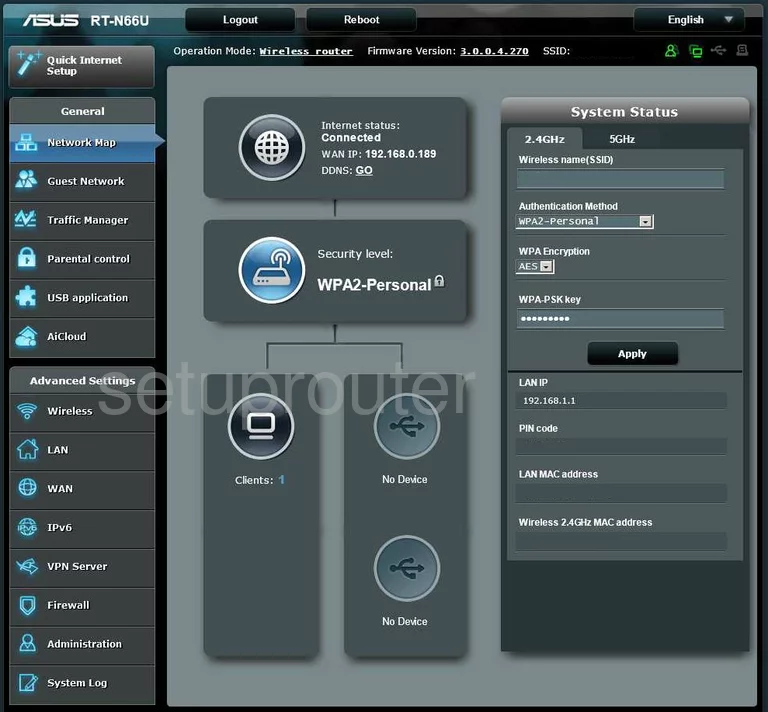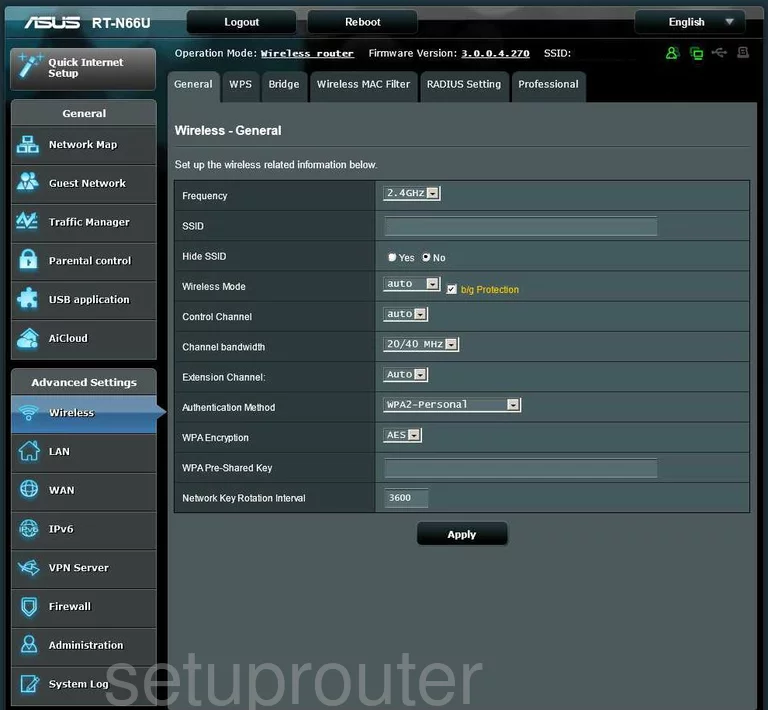The Asus RT-N66U router is considered a wireless router because it offers WiFi connectivity. WiFi, or simply wireless, allows you to connect various devices to your router, such as wireless printers, smart televisions, and WiFi enabled smartphones.
Other Asus RT-N66U Guides
This is the wifi guide for the Asus RT-N66U. We also have the following guides for the same router:
- Asus RT-N66U - How to change the IP Address on a Asus RT-N66U router
- Asus RT-N66U - Asus RT-N66U Login Instructions
- Asus RT-N66U - Asus RT-N66U User Manual
- Asus RT-N66U - Asus RT-N66U Port Forwarding Instructions
- Asus RT-N66U - How to change the DNS settings on a Asus RT-N66U router
- Asus RT-N66U - How to Reset the Asus RT-N66U
- Asus RT-N66U - Information About the Asus RT-N66U Router
- Asus RT-N66U - Asus RT-N66U Screenshots
- Asus RT-N66U Tomato v1.28 - Asus RT-N66U Login Instructions
- Asus RT-N66U Tomato v1.28 - How to Reset the Asus RT-N66U
- Asus RT-N66U Tomato v1.28 - Asus RT-N66U Screenshots
- Asus RT-N66U Tomato v1.28 - Information About the Asus RT-N66U Router
- Asus RT-N66U v3.0.0.4.382_51636 - Asus RT-N66U Screenshots
- Asus RT-N66U v3.0.0.4.382_51636 - Information About the Asus RT-N66U Router
- Asus RT-N66U v3.0.0.4.382_51636 - Reset the Asus RT-N66U
- Asus RT-N66U v3.0.0.4.382_51636 - Login to the Asus RT-N66U
- Asus RT-N66U v5 Sabai - How to change the IP Address on a Asus RT-N66U router
- Asus RT-N66U v5 Sabai - Asus RT-N66U Login Instructions
- Asus RT-N66U v5 Sabai - How to change the DNS settings on a Asus RT-N66U router
- Asus RT-N66U v5 Sabai - Setup WiFi on the Asus RT-N66U
- Asus RT-N66U v5 Sabai - How to Reset the Asus RT-N66U
- Asus RT-N66U v5 Sabai - Asus RT-N66U Screenshots
- Asus RT-N66U v5 Sabai - Information About the Asus RT-N66U Router
WiFi Terms
Before we get started there is a little bit of background info that you should be familiar with.
Wireless Name
Your wireless network needs to have a name to uniquely identify it from other wireless networks. If you are not sure what this means we have a guide explaining what a wireless name is that you can read for more information.
Wireless Password
An important part of securing your wireless network is choosing a strong password.
Wireless Channel
Picking a WiFi channel is not always a simple task. Be sure to read about WiFi channels before making the choice.
Encryption
You should almost definitely pick WPA2 for your networks encryption. If you are unsure, be sure to read our WEP vs WPA guide first.
Login To The Asus RT-N66U
To get started configuring the Asus RT-N66U WiFi settings you need to login to your router. If you are already logged in you can skip this step.
To login to the Asus RT-N66U, follow our Asus RT-N66U Login Guide.
Find the WiFi Settings on the Asus RT-N66U
If you followed our login guide above then you should see this screen.

You begin on the Network Map of the Asus RT-N66U router. To configure your WiFi settings, click the link on the left side of the page labeled Wireless. Then look to the top of the page and be sure that the tab is chosen labeled General.
Change the WiFi Settings on the Asus RT-N66U

Some of the settings on this page can be left alone, but there are a few that need to be changed as soon as possible.
- The first is the SSID setting. This is your networks name. The name you give your network to identify it from others around you. Go ahead and create an original name here, but avoid using anything that will point to you, such as your name or address. Wireless names is our guide on the topic if you would like some more information on the topic.
- Next is the Control Channel. You should be sure you are on the correct channel, 1,6, or 11. Overlapping channels do not communicate well with each other, so you should completely share a channel or be at least five channels away. There is only room in the spectrum for three channels that do not overlap each other, channels 1,6, and 11. Check out our guide on the topic, WiFi channels, for more information on why you should only be using one of these three channels.
- Next, is the Authentication Method. We strongly recommend using WPA2-Personal for your home network. WEP vs. WPA is a great guide on the subject if you are interested in learning more.
- Below that is the WPA Encryption. This is asking how you want to encrypt your data. There are two main choices here, TKIP and AES. We highly recommend using AES. It is at the moment considered uncrackable.
- Finally, change the WPA Pre-Shared Key. Do not leave this at the default setting. This is your password you use to access your network. Change this to a strong password of at least 20 characters. Avoid using anything that is easy to guess such as personal information, and dictionary words. Dictionary words are especially easy because a potential hacker has programs that try all the dictionary words very quickly. If you need to use words, misspell them. We do suggest using capital letters in the middle of the password. Another good idea is to use symbols and numbers in place of letters. How to choose a strong password is a great guide on the topic if you would like more help.
- When you are finished, click the Apply button before you exit.
Possible Problems when Changing your WiFi Settings
After making these changes to your router you will almost definitely have to reconnect any previously connected devices. This is usually done at the device itself and not at your computer.
Other Asus RT-N66U Info
Don't forget about our other Asus RT-N66U info that you might be interested in.
This is the wifi guide for the Asus RT-N66U. We also have the following guides for the same router:
- Asus RT-N66U - How to change the IP Address on a Asus RT-N66U router
- Asus RT-N66U - Asus RT-N66U Login Instructions
- Asus RT-N66U - Asus RT-N66U User Manual
- Asus RT-N66U - Asus RT-N66U Port Forwarding Instructions
- Asus RT-N66U - How to change the DNS settings on a Asus RT-N66U router
- Asus RT-N66U - How to Reset the Asus RT-N66U
- Asus RT-N66U - Information About the Asus RT-N66U Router
- Asus RT-N66U - Asus RT-N66U Screenshots
- Asus RT-N66U Tomato v1.28 - Asus RT-N66U Login Instructions
- Asus RT-N66U Tomato v1.28 - How to Reset the Asus RT-N66U
- Asus RT-N66U Tomato v1.28 - Asus RT-N66U Screenshots
- Asus RT-N66U Tomato v1.28 - Information About the Asus RT-N66U Router
- Asus RT-N66U v3.0.0.4.382_51636 - Asus RT-N66U Screenshots
- Asus RT-N66U v3.0.0.4.382_51636 - Information About the Asus RT-N66U Router
- Asus RT-N66U v3.0.0.4.382_51636 - Reset the Asus RT-N66U
- Asus RT-N66U v3.0.0.4.382_51636 - Login to the Asus RT-N66U
- Asus RT-N66U v5 Sabai - How to change the IP Address on a Asus RT-N66U router
- Asus RT-N66U v5 Sabai - Asus RT-N66U Login Instructions
- Asus RT-N66U v5 Sabai - How to change the DNS settings on a Asus RT-N66U router
- Asus RT-N66U v5 Sabai - Setup WiFi on the Asus RT-N66U
- Asus RT-N66U v5 Sabai - How to Reset the Asus RT-N66U
- Asus RT-N66U v5 Sabai - Asus RT-N66U Screenshots
- Asus RT-N66U v5 Sabai - Information About the Asus RT-N66U Router